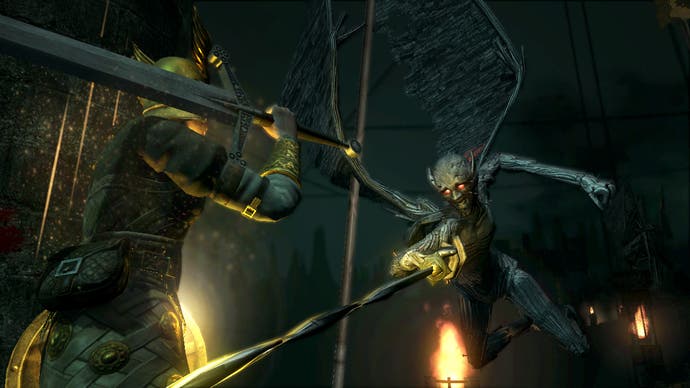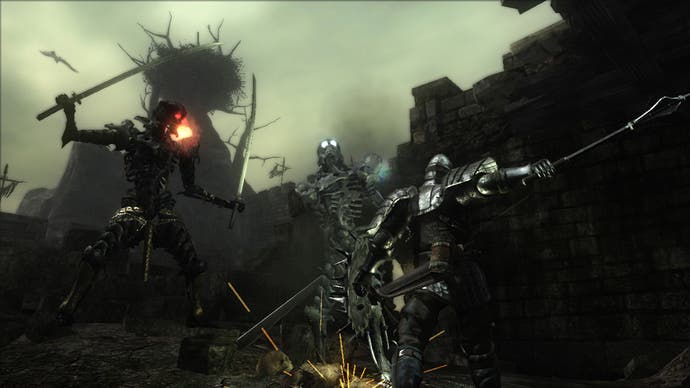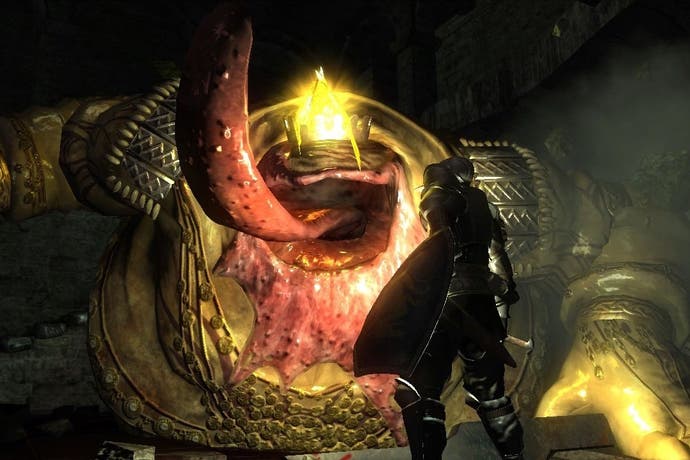Demon's Souls still feels fresher than its "Dark" successors
Jeffrey revisits Boletaria and finds much has changed.
Souls. Souls have changed. As a colossal fan of From Software's Souls series, I found myself pining for more demon slaughter even after finishing the latest Dark Souls 2 downloadable content. Yet Dark Souls 2 itself was still too recent in my mind, while the first one I replayed a couple of years back when its Artorias of the Abyss DLC came out. So I decided that it was time to revisit the game that started it all: 2009's Demon's Souls.
What a difference five years and two spiritual successors make! And I don't mean this in a bad way. Demon's Souls doesn't just hold up, it feels fresher and more innovative today than either of its "Dark" brethren.
On the surface, the Souls series hasn't changed much. Its unique control scheme, gruelling economy, and most of its items have remained the same over the years, but the actual feel of the games couldn't be more different when you place Dark Souls 2 side by side with Demon's Souls.
There are a few reasons for this, but arguably the most important is that Demon's Souls is more open-ended than either of its successors. People tend to think of Demon's Souls as a linear game full of isolated stages, while its Dark descendants opted for an open-world. These people are wrong. After its opening level, Demon's Souls allows you to tackle its five domains in any order. I can't recall ever having that many open roads in either Dark Souls game, which usually limited your available paths to two or three routes.
Chances are high that you'll do a lot of swapping between these five distinct branches, as each one scales in difficult rather quickly. There's no shame in bailing on one route only to come back later. In fact, you're actively encouraged to do just that as the game's beginning is vastly more impenetrable than either Dark title.

Take how its magic system works. There are two kinds of magic: Spells and Miracles. The former is generally offensive attacks, while the latter is defensive. So far so good, but figuring out how to actually cast magic is a deliciously bewildering process. Miracles require a Talisman to cast, while Spells require a Catalyst. Figuring out where to find either is not explained at all, and they're not necessarily in obvious locations at the start of the adventure. If you're new to the game you could easily spend your first dozen hours with the magic meter taunting you on your HUD, yet remaining completely inaccessible.
This may sound evil - and it is - but it's really quite wonderful. It genuinely makes the player feel incredibly lost, scared and overwhelmed in the opening hours. The Dark Souls games, by comparison, are a lot more gentle in introducing their core mechanics and wouldn't dare let you miss something that vital while you're still finding your sea legs.
The health system, too, makes Demon's a much more frightening place to start out. While the Dark Souls games have some mighty difficult bosses (I'm looking at you, Ornstein & Smough), you could use up all of your healing items only to respawn with a full stock again. Demon's doesn't let you get away with that. You can use up a good dozen HP-replenishing herbs on a boss only to die and lose them all forever, ending up at a greater disadvantage than when the fight began. This makes even practicing a boss and observing its patterns a stressful activity. In short: it feels like there's a lot more at stake in Demon's Souls.

Aside from Demon's Souls' structure being bigger, meaner and more confusing than that of the Dark games, it's also visually refined in a way that's more consistent than either of its successors. Despite its title, Dark Souls is actually a significantly brighter game than Demon's Souls (and Dark 2 is even brighter yet). This isn't always a bad thing. The Dark games have had a more diverse set of locales, with sun-kissed ivory palaces balancing out the gloomy mires and grimy caves. On one hand, these more grandiose vistas are gorgeous and varied. On the other, the better-lit scenery allows you to see your foes just standing there, like statues, waiting to be activated like the world's deadliest sprinkler system.
Demon's Souls' visuals are a lot darker, with three of its five areas shrouded in shadows, while the remaining locales are grey and overcast. This isn't as diverse as some games, but the moody lighting makes it so you generally can't even see your foes until they're right upon you. This near-sighted field of view is exacerbated by the generally claustrophobic level design, full of narrow corridors and tight stairwells. Navigating its compact environments feels imposing and endless, like you're a mole digging through a complicated cave system and only occasionally catching a glimpse of the world above. Naturally, this limited viewing angle makes Demon's Souls a relentlessly unnerving experience that the Dark games only touched on in bits and spurts.
It's not just Demon's open-ended nature and dim aesthetic that makes From's classic more unsettling than its successors either, as its far-apart checkpoints require players to commit in a way that was less emphasised in later series entries. Some of these levels are long. Really long. I spent upwards of 40 minutes combing a swamp for goodies before I was able to unlock a shortcut to its boss. Because Demon's stages are so lengthy and treacherous, their shortcuts actually mean something. Comparatively, Dark Souls 2 caught some flak for its overly accessible fast-travel system being unlocked from the get go, but even the first Dark Souls' bonfires were much closer together than Demon's archstones.

Demon's Souls is also a much stranger and more surprising game than its Namco-published successors. It switches its mechanics up on a you a lot more than other Souls titles and nowhere is this more prevalent than in its incredibly varied rogue's gallery of bosses. In a really audacious move, many of its highest-ranking demons are intentionally wimpy by design. One is placed beside a gargantuan sword that rips the sky to pieces, another is defeated by interacting with the scenery after some survival-based puzzling, and another actually commits suicide if you defeat her lover. Even the grande finale is a wonderfully subversive anticlimax where you've valiantly fought for dozens of hours to face off against the demon god The Old One only to find a sad and pathetic creature inside in need of being put out of its misery. Like Shadow of the Colossus before it or The Last of Us after it, there's a palpable sense of pathos and pity surrounding some of Demon's Souls' most corrupt denizens.
As much as I've been enjoying Dark Souls 2 and its add-ons, I can't help but feel that ploughing through its colossal landscape feels a little workmanlike. The combat is still rock solid and the world remains interesting, but it doesn't have that unconventional spark of Demon's Souls. That NPC who you think you'll be rewarded for rescuing only to discover that he starts murdering the game's most essential characters; the boss who respawns infinitely unless you do something else to make her mortal; the boss that's actually another player plucked from their world and summoned into yours with the sole objective of killing you... These are the flourishes of legend. It makes Hideo Kojima's madcap meta sensibilities look tame, and while the Dark Souls games tried to capture this spirit, neither successor quite nailed that impermeable feeling that Demon's brought to the table over five years ago.
Ultimately, I'd liken the Demon's/Dark progression to that of the difference between the original Zelda and A Link to the Past. ALTTP isn't that hand-holding relative to most games, but compared to the NES The Legend of Zelda, it's downright straightforward. That's pretty much exactly how the Souls series has evolved as its audience and potential platforms grew.
Will series creator Hidetaka Miyazaki's next foray into the director's chair, Bloodborne, rekindle his fascination with the absurd and seemingly insurmountable? It's hard to say, even if the trailers suggest a world more aesthetically similar to Demon's Souls' onyx palette. But I really hope it does. I want more bosses that aren't merely cool-looking knights or dragons, but rather strange and diverse creatures that run the gamut from the majestic to the ghastly. I want more navigational options that force us to fight tooth and nail before we find our first set of armour. I want fewer checkpoints and larger stakes.
But mostly, I want Bloodborne to surprise me - not just the way Demon's Souls shook the vanilla, mollycoddling sensibilities mainstream games all conformed to at the time, but rather the way it continues to inspire and delight over half a decade later.

